Description of cherry plum and the subtleties of its cultivation
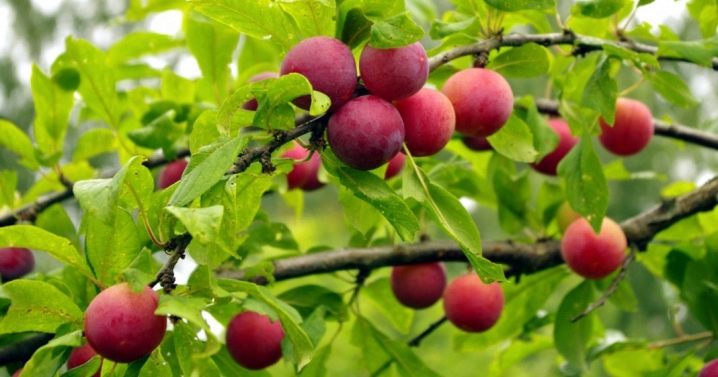
Cherry plum is a plant that is also known as cherry plum or splayed plum. A tree with delicious fruits can be found in many areas, because gardeners like these unpretentious and beautiful plants.
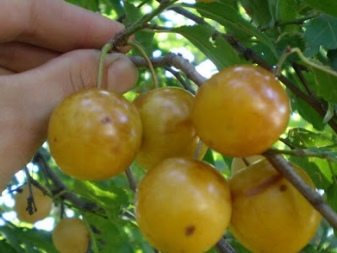
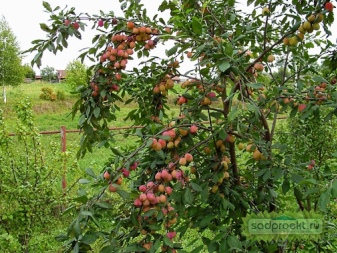
Description
Cherry plum is a member of the Pink family. Her life form is a tree or shrub. The homeland of this plant is Asia Minor. Cherry plum can grow in height up to 3-7 meters on average. The stems of this tree are green-brown in color. They are covered with thin bark. The root system of such a tree is powerful.
Cherry plum leaves are elongated in length and slightly pointed. In spring, cherry plum, like other trees in the garden, blooms. This usually happens in the first days of May. During flowering, the plant looks like an ornamental plum. Cherry plum flowers can be painted white or purple. Cherry plum is an excellent honey plant, so it actively attracts pollinators.

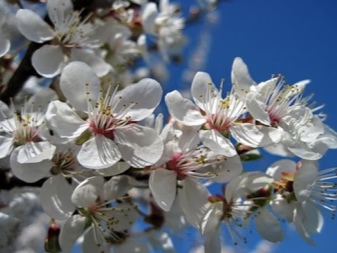
Cherry plum fruits can be yellow, red, pink or even purple. Each berry is covered with a thin layer of waxy coating. The fruits are small. Inside each of them is a small bone. Cherry plum has a pleasant, slightly sour taste. Since the fruits contain a minimal amount of sugar, they can be eaten even by diabetics or overweight people.
It should be noted that most varieties of this plant are self-fertile. That is, in order for the fruits to appear on the cherry plum, it is worth planting not one, but 2-3 trees on the site. It is important that they bloom at the same time.
Cherry plum is a rather unpretentious tree. Previously, it could only be grown in regions with a warm climate. But now there are frost-resistant hybrids that bear fruit well even in cold regions.

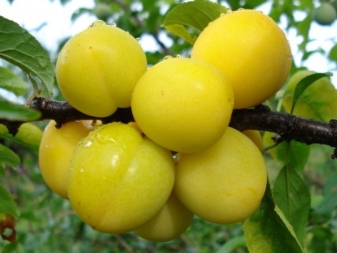
Varieties
There are many different varieties of cherry plum, which differ in their characteristics and taste.
- "Huck"... The berries of this cherry plum ripen late. They are yellow and sweet and sour. The plant is distinguished by good disease resistance and winter hardiness. The tree begins to bear fruit in the 3rd year after planting. This cherry plum variety is ideal for the Kuban.
- "Caucasian"... This is a wild cherry plum, which is widespread in Asia Minor. Its fruits are yellow and slightly sour. Dark berries are rare. In the wild, these plants form dense thickets.
- "Eastern"... In nature, this cherry plum can be found in Iran or Afghanistan. Its main difference is its smaller berries. They can be either yellow or purple. The taste of such berries is more astringent.
- "Oriole"... This tree has beautiful and bright yellow fruits. He has high winter hardiness. Therefore, it can be planted in cold regions.
- "Vitba"... This variety is small in size. The fruits of this cherry plum are yellow, with a bright blush. Their taste is sweet. The tree is characterized by good disease resistance.
- "Cleopatra"... The fruits of such a tree are large and dark purple in color. The plant begins to bear fruit in the 4th year after planting.
- "Mashenka"... A medium-sized tree bears fruit in the first half of summer. Its fruits are dark, prone to cracking. The cherry plum stone separates well from the pulp. The berries have a pleasant taste. This cherry plum can be planted in Siberia.
- "Black Velvet". This plant is a hybrid of apricot and cherry plum. Its fruits are dark purple, covered with a short downy. The color of the fruit pulp is orange.Their aroma is similar to that of real apricots. This is one of the best varieties for planting in the middle lane.
- "Sigma"... Such a tree has reddish-yellow fruits. Their taste is sweet. The tree is small in size. It begins to bear fruit already in the 2nd year after disembarkation. The plant is characterized by excellent disease resistance.
- "Hollywood". The fruits of such a tree are red. Their flesh is yellowish-pink, and the taste is slightly sour. The tree bears fruit only 4-5 years after planting. The berries ripen early enough.
- "Traveler"... It is one of the earliest varieties of cherry plum with dark red fruits. The smell of the berries is rich, and the flesh is orange. The plant has good winter hardiness and disease resistance.
All these varieties are characterized by good yields and fit perfectly into the landscape design of the site.
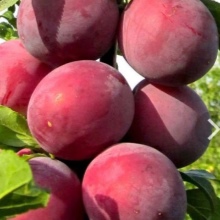
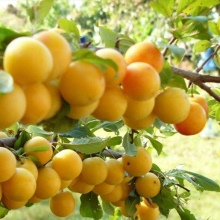

Landing
When planting cherry plum, it is important to take into account the peculiarities of the local climate. In warm regions, this procedure is usually carried out in the fall. In regions with frosty winters, it is postponed until spring.
Before starting planting, the gardener needs to select healthy seedlings. They must be one year old or two year old. Such plants take root on the site very quickly. It is best to choose seedlings grown in a local nursery. This way they will be able to quickly adapt to the desired climate.
When choosing seedlings, they must be carefully examined. They should not be damaged in any way. If the root system of the seedling is open, the plant should be planted in the soil immediately after purchase. If it is in a container, you can take your time.
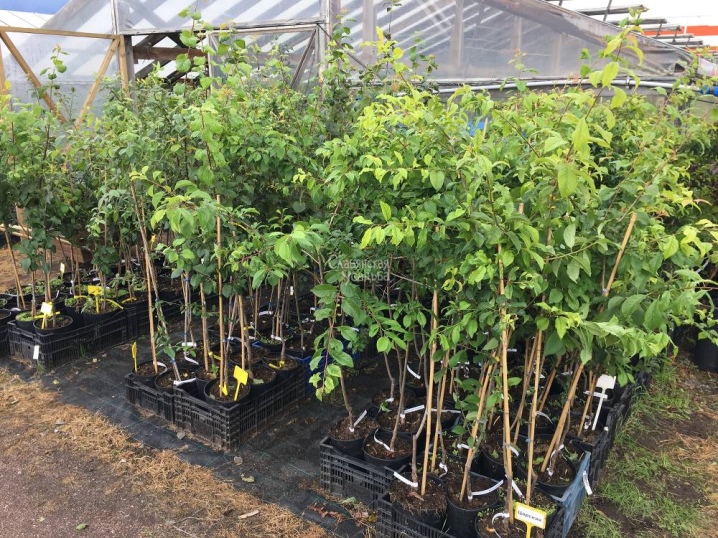
Having picked up suitable seedlings, you should proceed to finding a good place for planting cherry plums. In the process, you need to pay attention to the following points.
- The soil... Cherry plum loves not too acidic nutrient soil. It grows best on loam. If the acidity of the soil is increased on the site, it must first be deoxidized. For this, wood ash is most often used. In addition, before planting cherry plum, siderates can be planted on the site.
- Illumination of the site... Given the attitude of cherry plum to light, it is recommended to plant it in a well-lit area. This will help increase the yield and also make the fruit tastier.
- Windproof... The plant must be well protected from the wind. This is especially important for young seedlings. Therefore, cherry plum is most often planted next to a fence or some kind of building.

The next stage of planting cherry plum is the preparation of the pit. You need to do this in the last week of September. The hole should be wide enough for the rhizome to fit completely. At the bottom of the dug hole, you need to pour a mixture of fertile soil with humus and nitrophosphate. If several trees are planned to be planted on the site at once, the distance between them should be within 3 meters.
After 8-10 days, you can start planting the plant in the soil. It is recommended to place the roots of seedlings in a clay mash before planting. Some gardeners also add a small amount of a root growth stimulant there.
The plant prepared in this way must be carefully placed in the center of the pit. Holding it with your hand, the roots of the seedling must be covered with earth. It is worth remembering that a plant planted in the soil needs abundant watering. After carrying out this procedure, it is recommended to additionally fill the ground near the trunk with mulch.
If the gardener plans a spring planting of cherry plum, the pit is prepared in the same way in the fall. At the same time, seedlings are also bought. They are kept cool during the winter. Before planting, the rhizome of the plant must be carefully examined. It is necessary to plant cherry plum in the spring even before the start of sap flow.

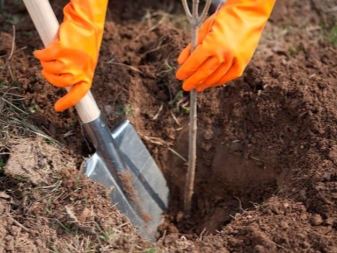
Care features
In order for the plant to grow and develop normally, it must be properly looked after. Cherry plum as a whole is quite unpretentious, so caring for it takes very little time.
Watering
First of all, the cherry plum must be watered.Only young seedlings need regular watering. Mature plants get enough moisture when it rains. But if the summer turned out to be dry, the cherry plum will have to be watered. This is usually done three times in the entire season.
It is important to use enough water when watering. The ground must be completely saturated with moisture.
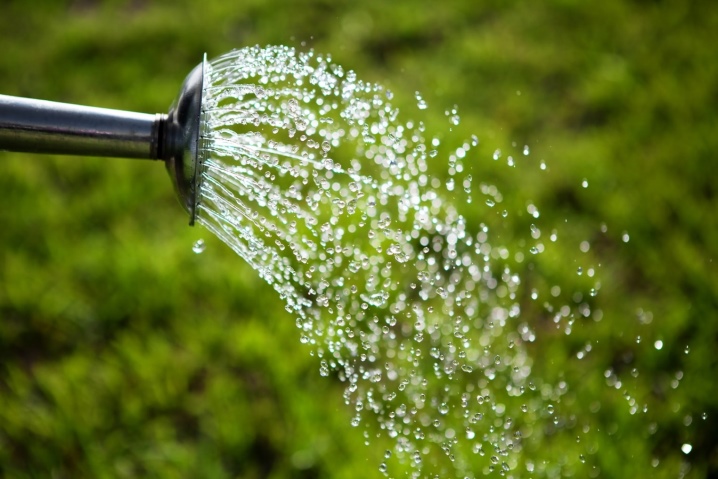
Top dressing
An equally important role in the process of growing cherry plum is played by top dressing. In the first year after planting the plant, you do not need to fertilize it. In the future, fertilizers are applied to the soil several times per season.
In the spring, even before flowering, the tree must be fed with nitrogen-containing fertilizer. This is necessary so that it grows quickly. In June, cherry plum can be fed with potassium and phosphorus.
In autumn, organic fertilizers are applied to the soil. Fertilizing with humus or compost is carried out after the end of the harvest.
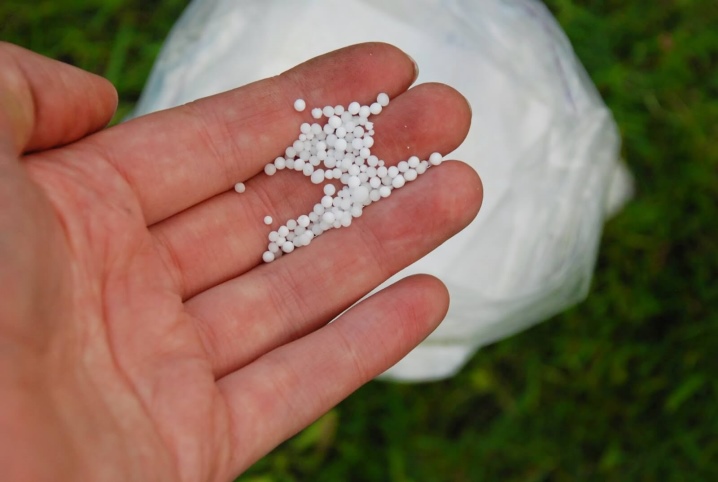
Pruning
Most gardeners prefer spring pruning of cherry plum. The crop, like other trees or shrubs, must be pruned before buds begin to swell on the branches. At this time, the grower removes all unnecessary branches. Thanks to such pruning, the crown becomes less dense. Therefore, the fruits that form on the branches receive more nutrients, and are also constantly in the sun.
If the plant is young, formative crown pruning is also carried out in spring or autumn.... At the same time, some of the branches are removed or shortened. It becomes much easier for gardeners to care for cherry plum with a neat crown. In addition, it is easier to harvest from such a tree. Formative pruning is usually done in the first days of April.
Sanitary pruning can be done in summer and autumn. In the process, all affected by disease or pests, as well as weakened branches, are removed. This procedure helps to heal the plant. In this case, all shoots cut off in the process must be burned.


Regardless of what time of the year the plant is pruned, this procedure must be treated carefully. Shoots are cut only with sharp scissors or pruning shears. The cut sites are treated with garden pitch. All instruments are well disinfected.
Preparing for winter
A few weeks before the first frost, plants in the garden should be watered abundantly. This will help harden their roots. The garden area must be cleaned of plant residues. It is recommended to dig up the soil.
Mature trees have good cold resistance. But young seedlings need shelter. As a rule, the soil next to the trunk is covered with a thick layer of peat or humus. This mulch perfectly protects the roots of the plant from the cold.
After the first snow falls on the site, it should also be used as additional protection. In such conditions, cherry plum will be able to survive the winter without any problems.
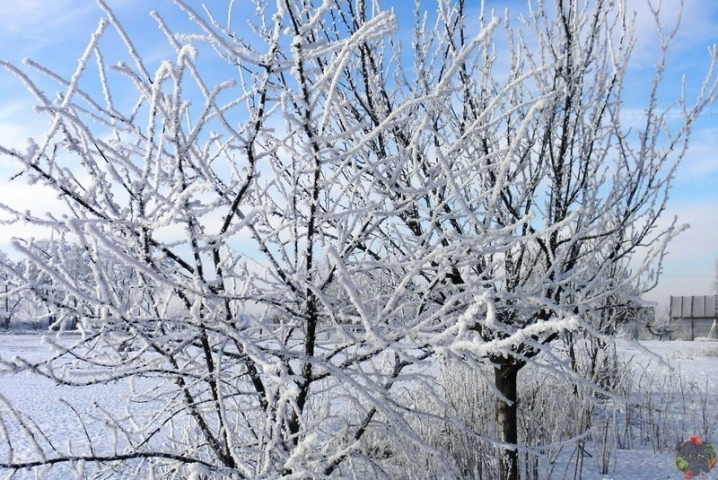
Reproduction
Cherry plum growing in the country can be propagated in several ways.
Undergrowth
This method is great for beginner gardeners.... You need to prepare for this procedure in the fall. At this time of year, the root on the mother tree should be carefully chopped off on one side. Young shoots will appear in this place by next autumn. As soon as it grows up, it will need to be carefully separated from the tree and transplanted to a new place.
The cherry plum growth is strong enough. Therefore, young shoots take root on the site rather quickly. Plants begin to bear fruit in a few years.
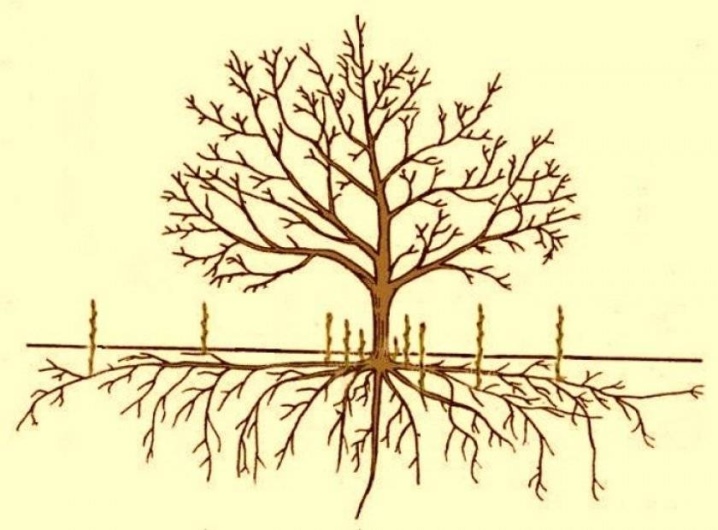
Root cuttings
Cuttings are the most popular method for propagating cherry plum. The planting material is separated from the tree in the fall. Each cutting should be approximately 25 centimeters long. Cut blanks must be placed in a wooden container and sprinkled with a mixture of peat, sawdust and sand. In this form, the cuttings are stored all winter.
In the spring, the plants need to be removed from the container with the substrate. To make it easier for the shoots to germinate the roots, their edges are treated with Kornevin. After that, the cuttings are planted in the soil prepared in advance. It is recommended to do this in the first half of May.Immediately after planting, the plants must be well watered. If cuttings are planted in the spring, they can take root before the first frost.

Vaccination
Cherry plum is usually planted in early spring or late summer. Green cuttings are used for grafting. In the process, a small incision is made on the branch. A stalk prepared in advance is attached to this part of the shoot. The junction is fixed with a rope. After a month, the fastening can be slightly loosened; after another two - remove.
Cherry plum can be grafted not only on a tree of another variety, but also on a plum. The vaccination schedule looks the same.
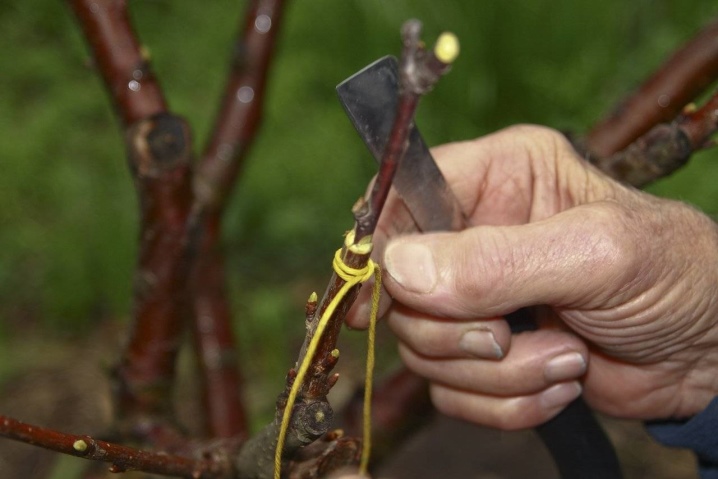
Underwire
Like many other fruits and berries, cherry plum can be propagated by seeds. To do this, even during fruiting, the gardener needs to choose ripe and juicy fruits without traces of damage. It is required to remove the bones from them.
Immediately after extraction, the seeds must be planted in the soil prepared in advance. The bones must be at least 5 cm apart. Immediately after disembarkation, the site must be well mulched.
Cherry plum is a pretty strong plant. Therefore, the seeds take root well. Naturally planted sprouts are well adapted to temperature changes, so they grow strong and healthy.
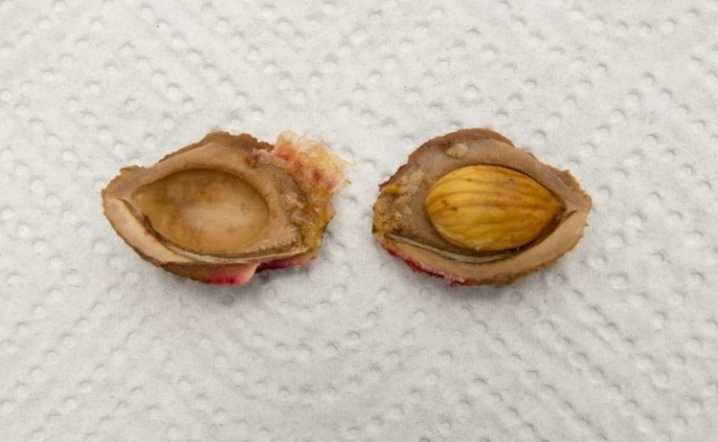
Diseases and pests
The danger for cherry plum is represented by fungal diseases. They spread quickly and infect not only this tree, but others as well. In order to prevent contamination of the site, it is recommended to treat it with copper sulfate. It is necessary to spray the area immediately after the spring pruning of the shoots.
Insects such as moths or leaf rollers can also harm plants. To protect the site from these pests, cherry plum is sprayed with insecticides in early April. Flowering trees cannot be processed.
It will help to protect the site from pests and timely cleaning of the garden, as well as pruning of branches.
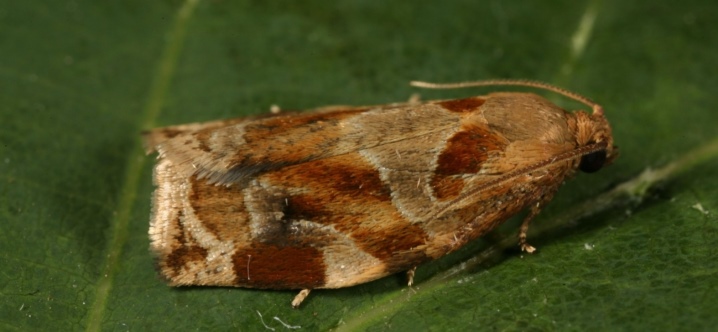
It is quite simple to grow cherry plum on your site. It is enough to pick up healthy seedlings and provide young plants with good care. A couple of years after planting cherry plum will delight the owners of the site with a rich harvest of delicious berries.







The comment was sent successfully.